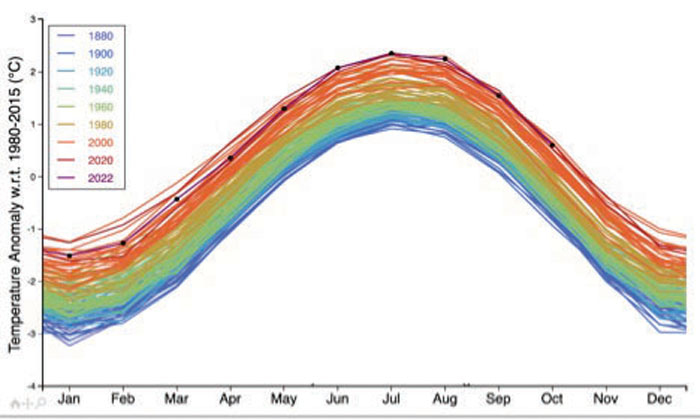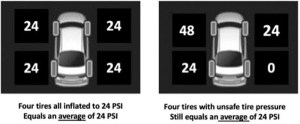Francis Koster: ‘Global warming,’ ‘climate change’ two different things
Published 12:00 am Sunday, November 27, 2022

- The average global temperatures between 1880, in bluer colors, and 2022.
By Francis Koster
I am the oldest of six kids. When I was growing up in Lakewood, Ohio, our (large) extended family would gather to share Thanksgiving dinner, reconnect with uncles, aunts and cousins, and drive my mom nuts with the bedlam created by a dozen or so primary school aged kids racing our small house around playing hide-and-seek.
Before the gathering, some of us kids were a bit intimidated by arrival of the not-often-seen uncles, aunts and cousins.
My mom sat us down and said we did not need to be shy with them – just get conversation started by ask them a question like “What do you think about the weather”, and then just sit and listen. “Everyone will feel comfortable, and get to know one another again”, she said.
That would not work today, would it? Before long, tension filled discussions would emerge about whether “Global Warming” or “Climate Change” is real.
The discussions will be messy in part because few on either side of the argument know those two terms mean.
Global Warming was first used in the 1950s[i].
Americans under 40 years old are far more likely to believe this data than older Americans, and so the generational divide debate begins. But in this case the tension not just caused by age – it is caused by the fact that almost none of the folks on either side of the argument have any idea what the chart is saying.
The key is the word “average”, found in the title of the graph. Do you know what it means? The “average” is calculated from 32,000 weather stations all around the word.[ii] To calculate an average, you take all 32,000 numbers, from the coldest to the hottest, add them up, divide them by 32,000, and that is the average. It can be very misleading.
If you are arguing with someone who lives in Phoenix, Arizona (111 days over 100 degrees in 2020)[iii], and you live in Grand Forks , North Dakota (yearly average temperature 42 degrees),[iv] your personal experience does not match what the scientists mean when they talk about the change in “global annual average temperatures.”

Four tires each inflated to 24 PSI at left averages 24 PSI while four tires with unsafe pressures that still average 24 PSI at right.
If you look at the image of tire pressure in your car, on the right side you will see a flat
tire in the right rear, and an almost-ready-to-explode tire in the left front tire. You can see how using “Average” can put your family at risk.
This is what led the scientists to use the phrase “Climate Change starting in the 1980s.
Climate Change refers to a number of ways to think about weather. It counts many things like changes in rainfall, snow, hot and cold days, humidity, wind speed, ocean temperature, and rising sea levels over a long period of time.
So – my advice to you as the holiday season arrives is to make sure that all the parties in the discussion define their terms. If possible, do not use the term “Global Warming” at all.
And when the youngsters hanging around your discussion express their anxiety about the future, tell them there a lot of things that they can do to slow down or stop this problem.
One fun and comforting thing you adults can do is help to replicate programs done all around the country that teach kids to plant trees on school grounds. These trees lower local average temperature, provide more comfortable outdoor play spaces, lower school air conditioning costs, and the leaves eat up some of the climate changing gasses, leading to a more comfortable environment.
A national program called Onetreeplanted has created a whole website containing instructions about how to set up a program, where to get funding for the trees, and curriculum materials that teachers can use to explain the role of trees in the climate change issue.[v] Just search the internet for it.
The City of Portland, Oregon has a program called Learning Landscapes that provides trees and instruction to students about how to plant them.
Closer to home, Charlotte Mecklenburg School System works with a group called TreesCharlotte that is dedicated to both teaching about the benefits of trees to the environment, and how to successfully plant them. The group has created curriculum modules for elementary, middle school, and high school teachers to weave into the science curriculum. The program has helped students plant 12,135 trees on school grounds since 2012.![vi]
It is time for adults to teach the next generation about the mess we are in, the correct words to use when talking about it, and what the younger-than-us can do to solve this problem. You need to teach them to plant a tree. Will you?
Francis Koster lives in Kannapolis and is a retired pediatric healthcare administrator who runs a not-for-profit organization called The Pollution Detectives.
[i] https://www.dictionary.com/e/new-words-surrounding-climate-change/
[ii] https://climate.nasa.gov/ask-nasa-climate/3071/the-raw-truth-on-global-temperature-records/
[iii] https://www.currentresults.com/Weather-Extremes/US/hottest-cities.php
[iv] https://housegrail.com/coldest-cities-in-the-us/#2_Grand_Forks_ND
[v] https://onetreeplanted.org/pages/school
[vi] https://treescharlotte.org/who-we-are/tree-success/

